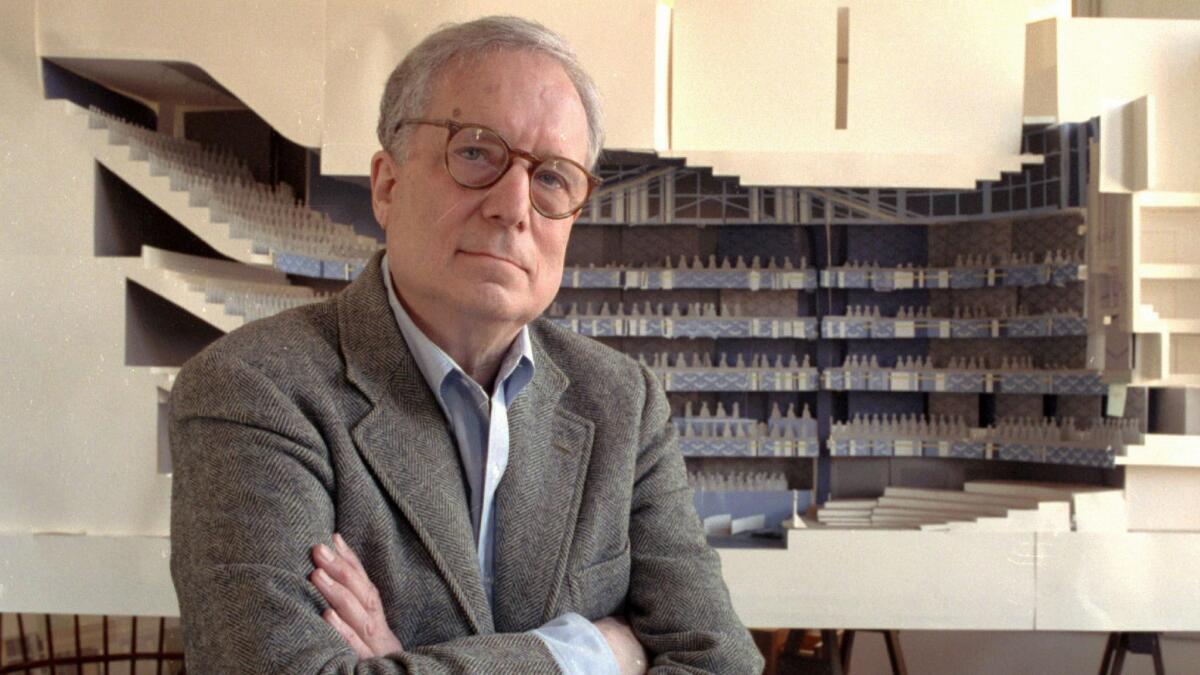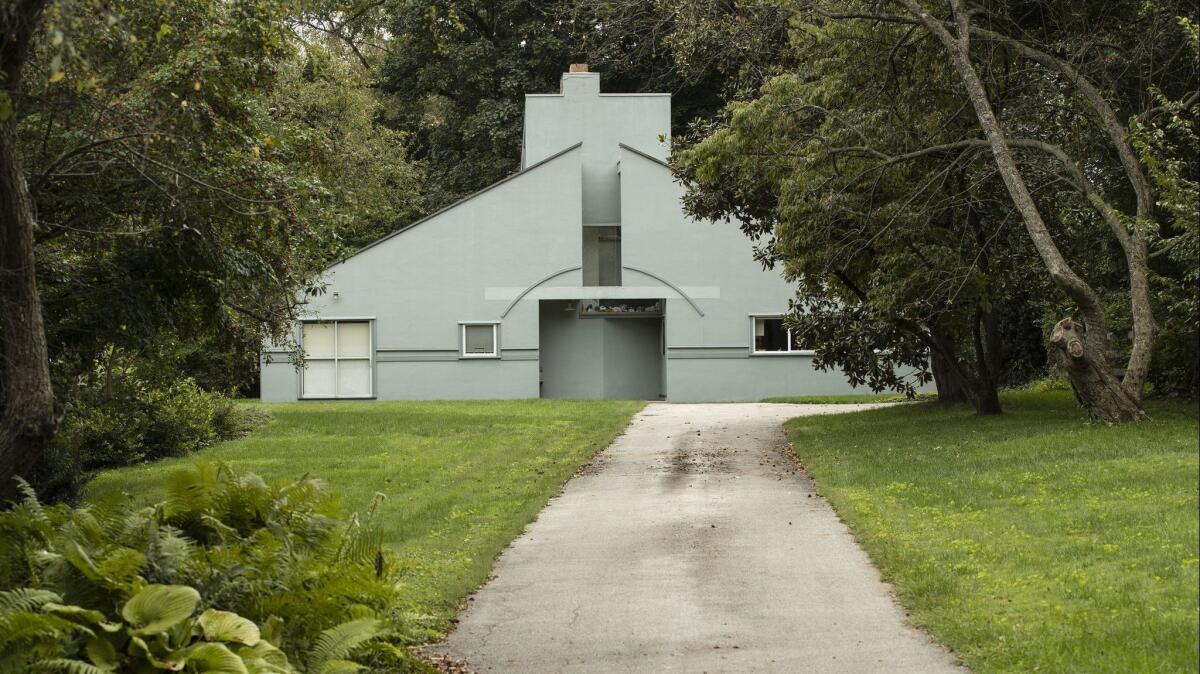Robert Venturi, architect who ushered in postmodernism, dies at 93

- Share via
Reporting from Philadelphia — Architect Robert Venturi, who rejected austere modern design and instead ushered in postmodern complexity with the dictum “less is a bore,” has died. He was 93.
His family released a statement on his firm’s website saying Venturi died Tuesday at home in Philadelphia after a brief illness, surrounded by his wife, architect Denise Scott Brown, and son, James Venturi.
He remained active well into his 80s at Venturi, Scott Brown & Associates, the architectural firm he founded in the 1960s. It’s now known as VSBA Architects + Planners.
“All of us at VSBA are heartbroken. Viva Bob,” the firm said in a statement.
Unlike the spare aesthetic of modernists like Mies van der Rohe, Venturi’s work celebrated complexity and even inconsistency in design. He encouraged architects and consumers to enjoy “messy vitality” in architecture — whether whimsical, sarcastic, humorous or honky-tonk.
Often referred to as the father of postmodernism, Venturi shunned the title, calling it “an easy catchphrase, the equivalent of a political sound bite.”
In 1991, Venturi was awarded the Pritzker Prize, architecture’s equivalent of the Nobel Prize, for “expanding and redefining the limits of architecture in this century, as perhaps no other has.”
“Architects today are too educated to be either primitive or totally spontaneous, and architecture is too complex to be approached with carefully maintained ignorance,” Venturi wrote in his 1966 manifesto against what he saw as the excesses of modernism: “Complexity and Contradiction in Architecture.”
In that book, Venturi established his “less is a bore” philosophy — in defiance of the minimalist approach to architecture espoused in Van der Rohe’s credo “less is more.”
The 1972 book “Learning from Las Vegas,” which Venturi and Scott Brown wrote with the late Steven Izenour, embraced the blinking facades and flashy signs of the Las Vegas strip as a reinvigoration of architectural design.
“Naturally, we were punished by the architecture establishment for being so vulgar,” Venturi said in a 1991 interview. “But we used it as a vehicle to learn about symbolism.”
In downtown Philadelphia, for example, a painted steel outline of the former site of Benjamin Franklin’s house serves as a monument, while a museum is buried underground. A firehouse near Walt Disney World in Florida is decorated with Dalmatian spots, and Venturi once proposed a 90-foot-tall red apple for Times Square in New York.
In 1978, Venturi set a series of 34-foot letters along the facade of the boxlike Basco showroom and warehouse in Philadelphia that spelled out the store name. In 1979, he had a windowless Best Products Co. showroom in suburban Langhorne painted over with enormous stylized red and white flowers.
He approached the design of living spaces with the same slant: Guild House, a senior housing complex in Philadelphia with a nonfunctional gilded TV antenna on top (it has since been removed), is loved or loathed by architects and residents alike.
“I think he’s one of the most important American intellectuals of the 20th century,” said David Brownlee, an expert on Venturi’s work and a professor at the University of Pennsylvania.
“He took an academic approach to architecture,” Brownlee said Thursday. “It wasn’t about style, it wasn’t about flash and shape. It was about seriously coming to terms with the material and intellectual challenge of the work.”
Removing architecture from its rarefied air was criticized by traditionalists who saw some of Venturi’s work as lacking in refinement, but he argued that buildings should reflect the culture in which they exist.
“Architecture must be tolerant of different tastes and cultures,” Venturi said. “There’s not just an elite culture. There is elite and folk cultures.”
Elsewhere, his most prominent works include the Seattle Art Museum, completed in 1991, which has been incorporated into a larger building, and the Sainsbury Wing of the National Gallery in London, also completed in 1991. Venturi became involved in the British project after Prince Charles denounced an earlier design as a “monstrous carbuncle.”
Venturi was born in Philadelphia on June 25, 1925, the son of a produce wholesaler. He earned his bachelor’s and master’s degrees at Princeton University.
From 1954 to 1956 he was a fellow at the American Academy in Rome. He returned to Philadelphia in 1957 to teach at the University of Pennsylvania and practice architecture, and quickly gained prominence in the so-called Philadelphia school of architects, dominated by the late Louis I. Kahn.
He founded his own practice in 1958. Scott Brown, whom he met at Penn and married in 1967, joined the firm that year and became a partner in 1969.
Venturi’s first notable building was a house he designed for his mother, Vanna, in the city’s Chestnut Hill neighborhood in 1961.

The building’s broken classical pediment that splits the gabled roof, and its overscaled moldings on each side of the symmetrically positioned doorway represented a major break from the established architectural thinking of the time: that a modern house should contain no historical elements.
Architect Frederick Schwartz referred to the Vanna Venturi House as “the first postmodern anything.”
The American Institute of Architects in 1989 named the Vanna Venturi House the winner of its 25 Year Award for its “enduring significance that has withstood the test of time.”
“A while back, when it was considered very daring, we did very simple things,” Venturi said in 1991. “We did buildings that looked ordinary, that were not trying to be revolutionary the way modern architecture was going to go.
“That horrified people. We did houses that looked like houses, elemental concepts of houses. We did fire stations that looked like fire stations.”
More to Read
Start your day right
Sign up for Essential California for the L.A. Times biggest news, features and recommendations in your inbox six days a week.
You may occasionally receive promotional content from the Los Angeles Times.






